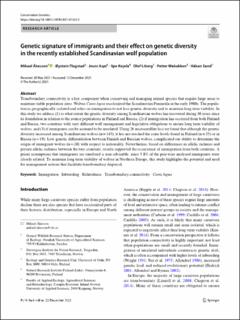| dc.contributor.author | Åkesson, Mikael | |
| dc.contributor.author | Flagstad, Øystein | |
| dc.contributor.author | Aspi, Jouni | |
| dc.contributor.author | Kojola, Ilpo | |
| dc.contributor.author | Liberg, Olof | |
| dc.contributor.author | Wabakken, Petter | |
| dc.contributor.author | Sand, Håkan | |
| dc.date.accessioned | 2022-06-22T07:15:12Z | |
| dc.date.available | 2022-06-22T07:15:12Z | |
| dc.date.created | 2022-01-14T18:00:37Z | |
| dc.date.issued | 2021 | |
| dc.identifier.citation | Conservation Genetics. 2021, . | en_US |
| dc.identifier.issn | 1566-0621 | |
| dc.identifier.uri | https://hdl.handle.net/11250/2999936 | |
| dc.description.abstract | Transboundary connectivity is a key component when conserving and managing animal species that require large areas to maintain viable population sizes. Wolves Canis lupus recolonized the Scandinavian Peninsula in the early 1980s. The population is geographically isolated and relies on immigration to not lose genetic diversity and to maintain long term viability. In this study we address (1) to what extent the genetic diversity among Scandinavian wolves has recovered during 30 years since its foundation in relation to the source populations in Finland and Russia, (2) if immigration has occurred from both Finland and Russia, two countries with very different wolf management and legislative obligations to ensure long term viability of wolves, and (3) if immigrants can be assumed to be unrelated. Using 26 microsatellite loci we found that although the genetic diversity increased among Scandinavian wolves (n = 143), it has not reached the same levels found in Finland (n = 25) or in Russia (n = 19). Low genetic differentiation between Finnish and Russian wolves, complicated our ability to determine the origin of immigrant wolves (n = 20) with respect to nationality. Nevertheless, based on differences in allelic richness and private allelic richness between the two countries, results supported the occurrence of immigration from both countries. A priori assumptions that immigrants are unrelated is non-advisable, since 5.8% of the pair-wise analyzed immigrants were closely related. To maintain long term viability of wolves in Northern Europe, this study highlights the potential and need for management actions that facilitate transboundary dispersal. | en_US |
| dc.language.iso | eng | en_US |
| dc.rights | Navngivelse 4.0 Internasjonal | * |
| dc.rights.uri | http://creativecommons.org/licenses/by/4.0/deed.no | * |
| dc.subject | Immigration | en_US |
| dc.subject | Inbreeding | en_US |
| dc.subject | Relatedness | en_US |
| dc.subject | Transboundary connectivity | en_US |
| dc.title | Genetic signature of immigrants and their effect on genetic diversity in the recently established Scandinavian wolf population | en_US |
| dc.type | Peer reviewed | en_US |
| dc.type | Journal article | en_US |
| dc.description.version | publishedVersion | en_US |
| dc.subject.nsi | VDP::Zoologiske og botaniske fag: 480 | en_US |
| dc.subject.nsi | VDP::Zoology and botany: 480 | en_US |
| dc.subject.nsi | Canis lupus | en_US |
| dc.source.pagenumber | 15 | en_US |
| dc.source.journal | Conservation Genetics | en_US |
| dc.identifier.doi | 10.1007/s10592-021-01423-5 | |
| dc.identifier.cristin | 1981561 | |
| dc.relation.project | Egen institusjon: Norwegian institute for nature research (NINA) | en_US |
| dc.relation.project | Egen institusjon: HINN | en_US |
| cristin.ispublished | true | |
| cristin.fulltext | original | |
| cristin.qualitycode | 1 | |

